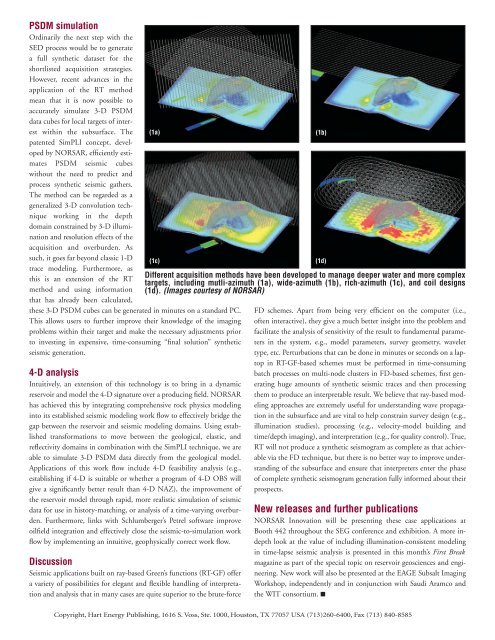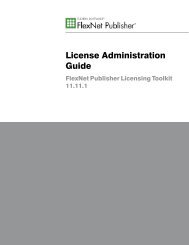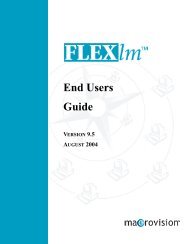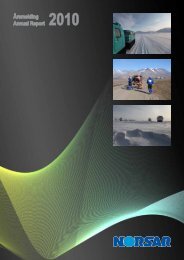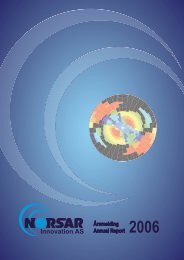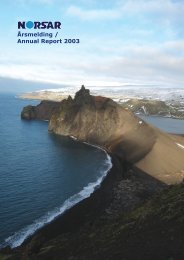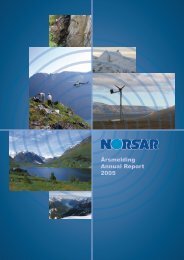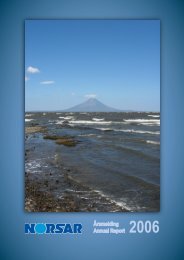SEG-RayTrace:Layout 1 - norsar
SEG-RayTrace:Layout 1 - norsar
SEG-RayTrace:Layout 1 - norsar
Create successful ePaper yourself
Turn your PDF publications into a flip-book with our unique Google optimized e-Paper software.
PSDM simulation<br />
Ordinarily the next step with the<br />
SED process would be to generate<br />
a full synthetic dataset for the<br />
shortlisted acquisition strategies.<br />
However, recent advances in the<br />
application of the RT method<br />
mean that it is now possible to<br />
accurately simulate 3-D PSDM<br />
data cubes for local targets of interest<br />
within the subsurface. The<br />
patented SimPLI concept, developed<br />
by NORSAR, efficiently estimates<br />
PSDM seismic cubes<br />
without the need to predict and<br />
process synthetic seismic gathers.<br />
The method can be regarded as a<br />
generalized 3-D convolution technique<br />
working in the depth<br />
domain constrained by 3-D illumination<br />
and resolution effects of the<br />
acquisition and overburden. As<br />
such, it goes far beyond classic 1-D<br />
trace modeling. Furthermore, as<br />
this is an extension of the RT<br />
method and using information<br />
that has already been calculated,<br />
these 3-D PSDM cubes can be generated in minutes on a standard PC.<br />
This allows users to further improve their knowledge of the imaging<br />
problems within their target and make the necessary adjustments prior<br />
to investing in expensive, time-consuming “final solution” synthetic<br />
seismic generation.<br />
(1a) (1b)<br />
(1c) (1d)<br />
4-D analysis<br />
Intuitively, an extension of this technology is to bring in a dynamic<br />
reservoir and model the 4-D signature over a producing field. NORSAR<br />
has achieved this by integrating comprehensive rock physics modeling<br />
into its established seismic modeling work flow to effectively bridge the<br />
gap between the reservoir and seismic modeling domains. Using established<br />
transformations to move between the geological, elastic, and<br />
reflectivity domains in combination with the SimPLI technique, we are<br />
able to simulate 3-D PSDM data directly from the geological model.<br />
Applications of this work flow include 4-D feasibility analysis (e.g.,<br />
establishing if 4-D is suitable or whether a program of 4-D OBS will<br />
give a significantly better result than 4-D NAZ), the improvement of<br />
the reservoir model through rapid, more realistic simulation of seismic<br />
data for use in history-matching, or analysis of a time-varying overburden.<br />
Furthermore, links with Schlumberger’s Petrel software improve<br />
oilfield integration and effectively close the seismic-to-simulation work<br />
flow by implementing an intuitive, geophysically correct work flow.<br />
Discussion<br />
Seismic applications built on ray-based Green’s functions (RT-GF) offer<br />
a variety of possibilities for elegant and flexible handling of interpretation<br />
and analysis that in many cases are quite superior to the brute-force<br />
Different acquisition methods have been developed to manage deeper water and more complex<br />
targets, including mutli-azimuth (1a), wide-azimuth (1b), rich-azimuth (1c), and coil designs<br />
(1d). (Images courtesy of NORSAR)<br />
FD schemes. Apart from being very efficient on the computer (i.e.,<br />
often interactive), they give a much better insight into the problem and<br />
facilitate the analysis of sensitivity of the result to fundamental parameters<br />
in the system, e.g., model parameters, survey geometry, wavelet<br />
type, etc. Perturbations that can be done in minutes or seconds on a laptop<br />
in RT-GF-based schemes must be performed in time-consuming<br />
batch processes on multi-node clusters in FD-based schemes, first generating<br />
huge amounts of synthetic seismic traces and then processing<br />
them to produce an interpretable result. We believe that ray-based modeling<br />
approaches are extremely useful for understanding wave propagation<br />
in the subsurface and are vital to help constrain survey design (e.g.,<br />
illumination studies), processing (e.g., velocity-model building and<br />
time/depth imaging), and interpretation (e.g., for quality control). True,<br />
RT will not produce a synthetic seismogram as complete as that achievable<br />
via the FD technique, but there is no better way to improve understanding<br />
of the subsurface and ensure that interpreters enter the phase<br />
of complete synthetic seismogram generation fully informed about their<br />
prospects.<br />
New releases and further publications<br />
NORSAR Innovation will be presenting these case applications at<br />
Booth 442 throughout the <strong>SEG</strong> conference and exhibition. A more indepth<br />
look at the value of including illumination-consistent modeling<br />
in time-lapse seismic analysis is presented in this month’s First Break<br />
magazine as part of the special topic on reservoir geosciences and engineering.<br />
New work will also be presented at the EAGE Subsalt Imaging<br />
Workshop, independently and in conjunction with Saudi Aramco and<br />
the WIT consortium. ■<br />
Copyright, Hart Energy Publishing, 1616 S. Voss, Ste. 1000, Houston, TX 77057 USA (713)260-6400, Fax (713) 840-8585


